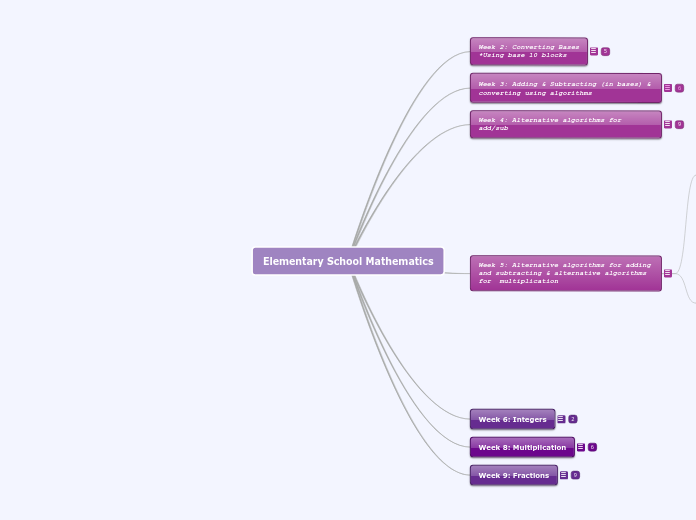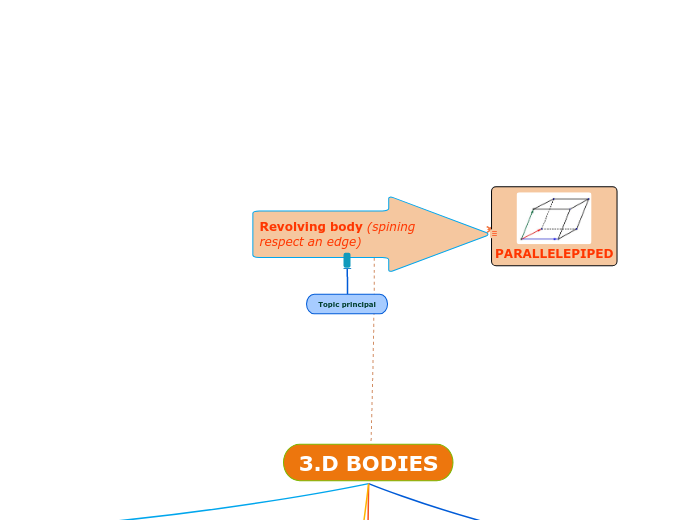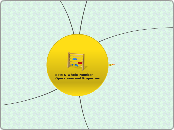Elementary School Mathematics
Week 9: Fractions
The reason we need common denominators when adding and subtracting and not when multiplying or dividing is because in the adding or subtracting case, we need equal sizes of the pieces. When multiplying or dividing isn't combining. It is more a group times what is inside the group.
Using boxes to add or subtract fractions
When adding, you use 3 boxes, when subtracting you use 2 boxes, and multiplying fractions requires 1 box when using simple numbers. Using complex numbers requires a simplifying method and then common denominators.
Linear Model
Comparing it to length and it talks about straight line corresponding to length
Compare sizes of shapes so you need the same shape
Set Model
Shape does not matter and they have common characteristics
Week 8: Multiplication
Multiplication is easy to learn if the two rules are remembered. The way problems are read is also important when solving these types of problems.
Rules
If signs are different, the answer will be negative.
6:40
If signs are the same, the answer will be positive.
Zero Banks: Only used if the first number has a (-).
With diagrams you have to match what the question is asking. Ex. 3(-6) would be 3 groups of negative 6. It is important to remember that -9(3) is the same as 0-9(3) so take away 9 groups of 3.
Week 6: Integers
Integers help with the idea of negatives. The idea of zero banks then is more apparent because in some situations you do not have enough of a given positive or negative. Also, when adding you get introduced to the idea of KCC (Keep Change Change).
Addition
For addition you draw a diagram. Writing the value of the numbers on top, (-- +, ++ -). If - +, subtract the numbers, if - - or + +, add the numbers and use the sign that is left.
Week 5: Alternative algorithms for adding and subtracting & alternative algorithms for multiplication
Similar to add/sub, these algorithms are useful in visually seeing what is being multiplied. Remembering place value is important to make sure the correct value, such as hundreds or ones, is being multiplied correctly. Place value is important!
Multiplication
Array
Once again, this helps visually see what is being multiplied
ex. 4(3) would look like:
. . .
. . .
. . .
. . .
Groups
Grouping helps to visually see what is being done
ex. 4(3) = 4 groups of 3, usually in a circle
Lattice works the same as in add/sub. Set up is similar, just multiply
Area Model
Area model creates a box, almost like expanded form
making it easier to multiply. After multiplying, simply add across then down.
Expanded form
Like addition and subtraction,
only this time you will be multiplying
the values
Base 10 blocks
Using this helps students visually see what
is being multiplied. It also makes it easy to
see longs, flats, and cubs, be made.
Alternative Algorithms for adding/subtracting
Lattice
This helps to keep number in order and it makes it easier to have students write down numbers in the way they normally would. Draw the box under the addition or subtraction
problem then add lines between the gaps of the numbers to create squares. Then connect diagonal lines from coroner to corner.
Equal add ins
This allows for the number to be put into simpler form making it easier to add/subtract
47-16 : add 3 to both
50-19 =31
Week 4: Alternative algorithms for add/sub
The alternative algorithms work similar for both adding and subtracting bases. It is important to note an important part:
When adding/subtracting in different bases, it is important to look for when units, longs, flats, etc... turn into the next bigger thing. Such as if you are adding 2 base 3 and 1 base 3, the answer will be 1o base 3 because the units turn into a long and zero units. Likewise if you are subtracting.
Scratch
Having the numbers aligned makes it easier when adding multiple numbers together. Depending on the base, counting the columns right to left, you will count until the base you are in and scratching when you get there. The number of scratches then transfers to the next column and so on.
*The base is 10
12
04
11
+03
= 20
Left-Right
Once again, this makes it easier as you can keep the values of the numbers in place and makes more sense than "carrying a one"
123
+321
(100+300)
+(20+20)
+(3+1)
Expanded Form
This method teaching students to expand their numbers and learn place value once again.
234 + 432 = (200+30+4 ) + (400+30+2).
Friendly Numbers/ Trading Off
This helps to get numbers to end in zeros which then allow to make adding or subtracting easier.
Week 3: Adding & Subtracting (in bases) & converting using algorithms
When converting bases using algorithms, it is important to know the value of the numbers you are using.
For example, going left to right, the values of the numbers 162085 would go as follows:
5 4 3 2 1 0
1 6 2 0 8 5
These values become important when using algorithms to convert others bases into base 10.
When converting other bases into base 10, backwards division is used (LLLLLLLeave). For example, turning 37 base 10 into base 8 would look like
8|37
|__
*It is important to remember that the numbers you get from dividing should never be bigger than the base you are converting to. So in the previous example, the biggest number can only be 7. Also, your remainder will go on the outside of the L.
8|37
|__
4|58
So the answer will be 45 base 8.
Converting using algorithms
*To and from base 10
To base 10: You will be solving! Almost like expanded form, you will be separating the number involved and using the desired base to convert to a different base. The numbers place value is important in knowing what number is used to squared to the base being converted. for example, 423, the 3 will be squared to 0, the 2 to 1, and the 4 to 2. So the problem "423 converted to base 5" will look like: 4(5^2)+2(5^1)_3(5^0).
From base 10: Remember LLLLLLLLeave base 10=Backwards division. It is important to remember that numbers cannot be bigger than the base that you wish to convert to!! The answer will be going from your last number divided and going right up after that.
Add/Sub in bases (Using base 10 blocks)
Line up, to show place value, your units, longs, flats, ect.. in such a way that it makes it easier for you to add/sub. It is important to note if adding results in a higher units, such as in base 3 you get 3 units, you must turn it into a long to avoid mistakes.
Week 2: Converting Bases
*Using base 10 blocks
The normal base used in the United States is base 10. When converting to base ten, it is important to note that there are units, that then turn to longs, that then turn into a flat, then to a cube. After this cycle, it becomes a bigger unit, bigger long, etc...
*Numbers can NEVER be = to the base you are in Ex. 45 base 5 does not work so 44 base 5 would be a better option*
Converting from Base 10 (using base 10 blocks)
The number that was once 10 turns into the base you
are wanting to convert to. Such as before, one long was 10, now, depending on the new base, it can vary from any number besides 10.
Converting to Base 10 (using base 10 blocks)
Count the number of units (using the pervious base as a reference) to turn into base 10.









